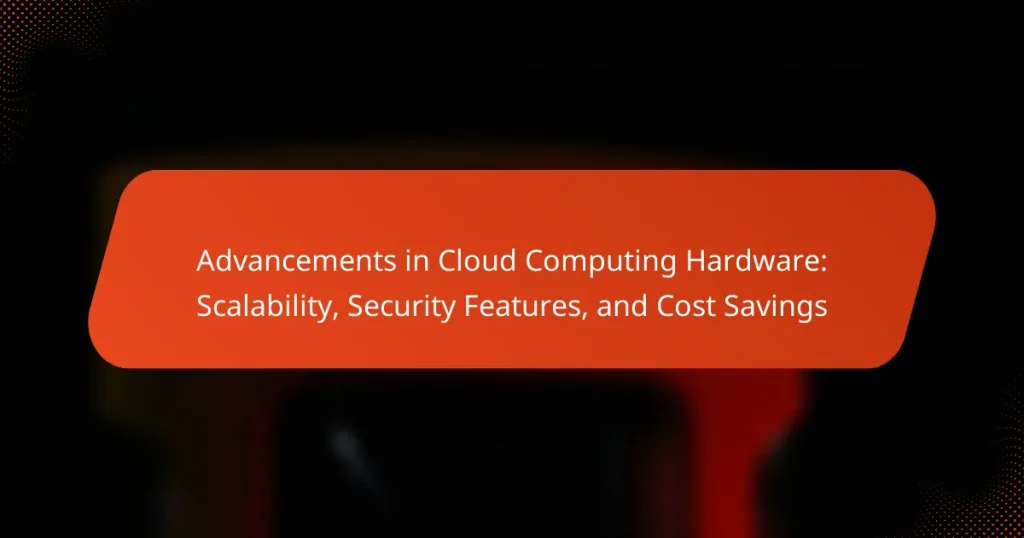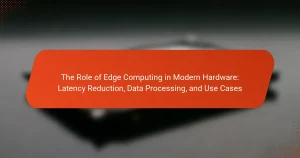Recent advancements in cloud computing hardware have led to significant improvements in processing power, energy efficiency, and data transfer capabilities. Key developments include enhanced processors like AMD’s EPYC and Intel’s Xeon, AI accelerators such as Google’s Tensor Processing Units, and faster storage solutions like NVMe SSDs. These innovations contribute to better scalability, security features, and cost savings for various industries, enabling organizations to optimize their cloud infrastructure. Best practices for upgrading cloud computing hardware include assessing infrastructure needs, selecting compatible hardware, budgeting for costs, testing new systems, and prioritizing security. Collectively, these advancements drive operational efficiency and innovation across multiple sectors.
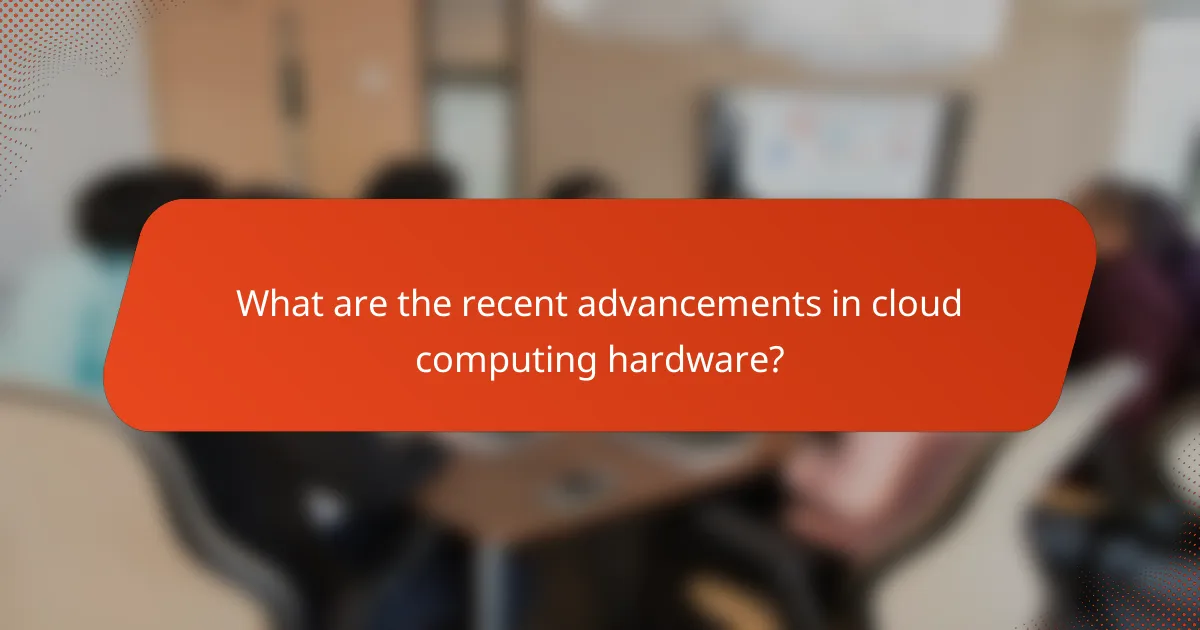
What are the recent advancements in cloud computing hardware?
Recent advancements in cloud computing hardware include enhanced processing power and improved energy efficiency. Newer processors, such as AMD’s EPYC and Intel’s Xeon, offer higher core counts and better performance per watt. Additionally, the integration of AI accelerators, like Google’s Tensor Processing Units, boosts machine learning capabilities in cloud environments. Storage technology has also evolved, with NVMe SSDs providing faster data access and reduced latency. Furthermore, advancements in network hardware, including 400G Ethernet, enhance data transfer speeds between cloud data centers. These developments collectively improve scalability, security, and cost savings for cloud service providers and users.
How have these advancements improved scalability?
Advancements in cloud computing hardware have significantly improved scalability by enabling dynamic resource allocation. This allows businesses to adjust their computing power based on demand in real-time. Enhanced virtualization technologies facilitate the efficient use of physical resources. These technologies reduce overhead and improve performance. Additionally, innovations in distributed computing architectures allow for better load balancing across multiple servers. This leads to increased availability and reduced downtime. According to a report by Gartner, companies leveraging these advancements can scale resources up to 80% faster than before. Overall, these developments create a more responsive and flexible cloud environment.
What technologies contribute to enhanced scalability in cloud computing?
Technologies that contribute to enhanced scalability in cloud computing include virtualization, containerization, and microservices architecture. Virtualization allows multiple virtual machines to run on a single physical server. This optimizes resource utilization and enables rapid scaling. Containerization packages applications and their dependencies into containers. This ensures consistency across environments and allows for quick deployment and scaling. Microservices architecture breaks applications into smaller, independent services. This enables teams to develop, deploy, and scale services independently, improving overall scalability. Additionally, serverless computing abstracts infrastructure management. This allows developers to focus on code while automatically scaling resources based on demand. These technologies collectively enhance the ability of cloud environments to adapt to varying workloads efficiently.
How do advancements in hardware architecture support scalability?
Advancements in hardware architecture support scalability by enabling systems to efficiently handle increased workloads. Modern architectures, such as multi-core processors and distributed systems, allow for parallel processing. This capability enhances performance as more resources can be utilized simultaneously. Additionally, advancements in virtualization technology facilitate the dynamic allocation of resources. This allows for scaling up or down based on demand without significant downtime. Moreover, innovations in memory architecture, like DDR4 and NVMe, improve data transfer rates. Faster data access reduces bottlenecks, further supporting scalability. According to a report by Gartner, companies leveraging scalable hardware architectures can improve operational efficiency by up to 30%.
What security features have been integrated into modern cloud computing hardware?
Modern cloud computing hardware integrates several advanced security features. These include hardware-based security modules, such as Trusted Platform Modules (TPMs). TPMs provide secure cryptographic functions and protect sensitive data. Another feature is secure boot, which ensures that only trusted software loads during the boot process. Encryption capabilities are also essential, enabling data protection both at rest and in transit. Additionally, multi-factor authentication enhances access security, requiring multiple forms of verification. Network security features, like firewalls and intrusion detection systems, monitor and protect against threats. These integrated security measures are designed to safeguard data integrity and confidentiality in cloud environments.
How do these security features protect data in the cloud?
Security features protect data in the cloud through encryption, access control, and monitoring. Encryption secures data by converting it into a coded format, making it unreadable without the correct decryption key. Access control restricts data access to authorized users, ensuring that only individuals with proper permissions can view or modify sensitive information. Monitoring involves tracking user activity and data access patterns to detect and respond to potential threats in real-time. These measures collectively enhance data integrity and confidentiality. According to the 2021 Cloud Security Report by Cybersecurity Insiders, 93% of organizations prioritize cloud security, highlighting the importance of these features in protecting cloud-stored data.
What role does encryption play in cloud hardware security?
Encryption is crucial for cloud hardware security. It protects sensitive data stored in the cloud by converting it into an unreadable format. Only authorized users with the correct decryption keys can access the original information. This process safeguards data from unauthorized access during storage and transmission. According to a report by the Cloud Security Alliance, 94% of organizations use encryption as a primary security measure. Additionally, encryption helps maintain regulatory compliance, such as GDPR and HIPAA, which mandate data protection. By implementing encryption, cloud service providers enhance overall security and build trust with users.
How do advancements in cloud computing hardware lead to cost savings?
Advancements in cloud computing hardware lead to cost savings through increased efficiency and reduced resource consumption. Modern hardware is designed for better energy efficiency, which lowers electricity costs. Enhanced processing power allows for faster data processing, reducing the time needed for tasks. This efficiency can decrease labor costs associated with managing and maintaining infrastructure.
Additionally, advancements in virtualization technology enable better resource allocation. This allows companies to use fewer physical servers while maximizing performance. According to a study by the International Data Corporation (IDC), organizations can save up to 30% on IT costs by adopting more efficient cloud solutions.
Moreover, scalable hardware solutions allow businesses to pay for only the resources they need. This flexibility prevents over-provisioning and under-utilization of resources, leading to further savings. Overall, these advancements create a more cost-effective cloud computing environment.
What factors contribute to reduced operational costs?
Reduced operational costs are influenced by several key factors. Efficient resource utilization minimizes waste and maximizes productivity. Automation of processes reduces the need for manual intervention, leading to lower labor costs. Cloud computing eliminates the need for expensive on-premises hardware and maintenance. Scalability allows businesses to adjust resources based on demand, avoiding over-provisioning. Energy-efficient technologies lower utility expenses. Streamlined supply chains reduce procurement costs. Data analytics optimize operational efficiency and identify cost-saving opportunities. These factors collectively contribute to significant reductions in operational costs for organizations.
How do hardware improvements affect overall efficiency and cost-effectiveness?
Hardware improvements enhance overall efficiency by increasing processing speed and reducing energy consumption. Faster processors can handle more tasks simultaneously, leading to quicker data processing. Improved memory technology allows for better multitasking and faster access to data. Reduced energy consumption lowers operational costs, contributing to cost-effectiveness. For instance, energy-efficient hardware can decrease electricity bills significantly. According to a study by the International Energy Agency, energy-efficient data centers can reduce energy costs by up to 30%. Overall, these advancements lead to better performance and lower long-term expenses.
What challenges do organizations face when adopting new cloud computing hardware?
Organizations face multiple challenges when adopting new cloud computing hardware. One significant challenge is integration with existing systems. Many organizations have legacy systems that may not easily connect with new cloud infrastructure. Another challenge is data security concerns. Organizations worry about potential breaches and compliance with regulations. Additionally, there is often a lack of skilled personnel. Finding employees who are trained in cloud technologies can be difficult. Cost management also poses a challenge. Organizations may struggle with understanding the total cost of ownership. Finally, performance issues can arise. New hardware may not meet the expected performance benchmarks, leading to dissatisfaction.
How can organizations overcome scalability challenges?
Organizations can overcome scalability challenges by adopting cloud computing solutions. Cloud platforms provide flexible resources that can scale up or down based on demand. This elasticity allows organizations to handle varying workloads efficiently. Implementing microservices architecture can also enhance scalability. It enables teams to develop, deploy, and scale services independently. Additionally, leveraging containerization technologies like Docker can streamline the deployment process. According to a report by Gartner, 70% of organizations using cloud infrastructure experience improved scalability. This statistic highlights the effectiveness of cloud solutions in addressing scalability issues.
What measures can be taken to ensure security during hardware transitions?
To ensure security during hardware transitions, organizations should implement several key measures. First, data encryption should be employed to protect sensitive information during the transfer process. This ensures that even if data is intercepted, it remains unreadable. Second, access controls must be strictly enforced. Only authorized personnel should have access to the hardware being transitioned. Third, thorough auditing of all hardware and data movements is essential. Regular audits help identify any unauthorized access or anomalies. Fourth, secure disposal methods for old hardware must be practiced. This prevents data recovery from decommissioned devices. Additionally, implementing a robust backup strategy is critical. Backups should be performed before any transition to prevent data loss. Lastly, employee training on security protocols is vital. Staff must be aware of potential threats and the importance of following security measures during transitions.
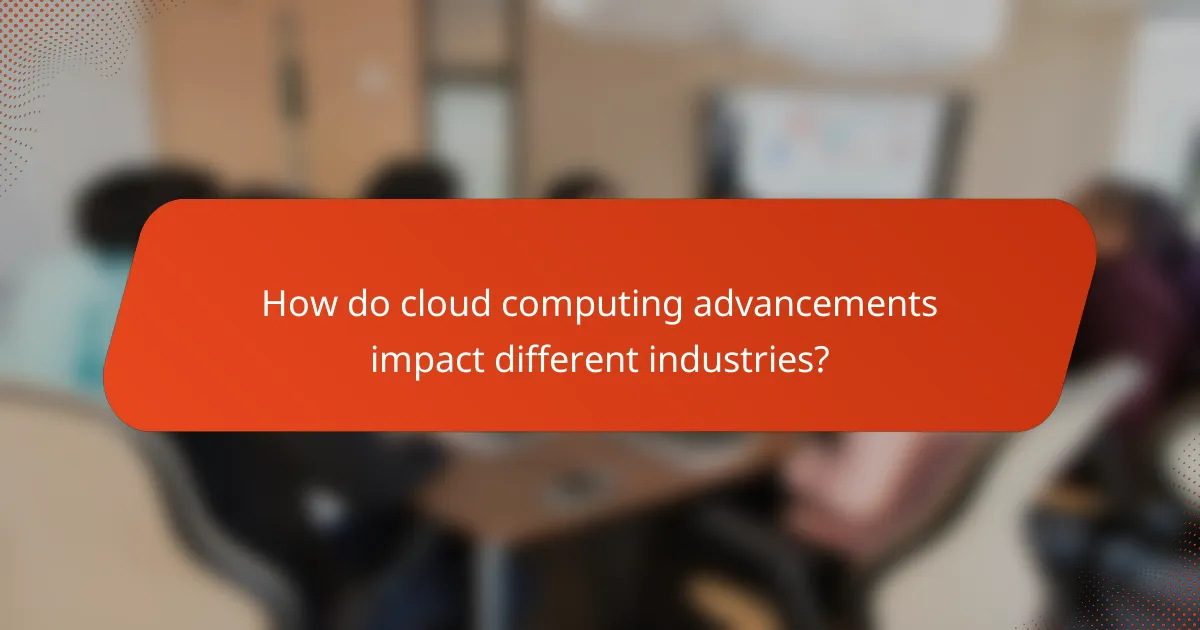
How do cloud computing advancements impact different industries?
Cloud computing advancements significantly impact various industries by enhancing scalability, improving security features, and reducing costs. Scalability allows businesses to adjust resources based on demand, leading to increased efficiency. For instance, the healthcare industry can quickly scale up data storage for patient records during emergencies. Improved security features protect sensitive information, which is crucial for finance and legal sectors. These industries benefit from advanced encryption and compliance measures. Cost savings arise from reduced infrastructure expenses. According to a study by Gartner, organizations can save up to 30% on IT costs by adopting cloud solutions. Overall, these advancements drive innovation and operational efficiency across multiple sectors.
Which industries are most affected by cloud hardware advancements?
The industries most affected by cloud hardware advancements include information technology, healthcare, finance, and retail. The information technology sector benefits from increased scalability and efficiency. Healthcare utilizes cloud advancements for improved data management and patient care. The finance industry leverages enhanced security features for transaction safety. Retail adopts cloud technology for better inventory management and customer experience. According to a report by Gartner, cloud adoption in these industries has accelerated by over 30% annually, demonstrating significant impact.
How does cloud computing hardware enhance operational efficiency in specific sectors?
Cloud computing hardware enhances operational efficiency by providing scalable resources tailored to specific sector needs. It allows businesses to adjust their computing power based on demand. This flexibility reduces the need for physical infrastructure investments. For example, in healthcare, cloud solutions enable rapid data access for patient records. In retail, they streamline inventory management and sales analytics. Studies show that organizations using cloud services can reduce operational costs by up to 30%. This efficiency is achieved through optimized resource allocation and reduced downtime. Furthermore, cloud hardware supports collaboration across teams, improving productivity.
What unique needs do different industries have regarding cloud hardware?
Different industries have unique needs regarding cloud hardware based on their operational requirements. For example, the healthcare sector requires high security and compliance with regulations like HIPAA. This necessitates cloud hardware with advanced encryption and access controls. The financial industry prioritizes low latency and high availability to support real-time transactions. This leads to a demand for robust, reliable cloud infrastructure.
Manufacturing often needs scalable solutions to handle fluctuating workloads. This requires cloud hardware that can easily expand resources as production demands change. Retail businesses focus on cost efficiency and speed, necessitating cloud solutions that optimize inventory management and customer experience.
Education institutions seek collaborative tools, requiring cloud hardware that supports multiple users and integrates easily with various software applications. Each industry, therefore, has distinct requirements that shape their cloud hardware choices, ensuring they align with specific operational goals and compliance standards.
What future trends are expected in cloud computing hardware?
Future trends in cloud computing hardware include increased adoption of edge computing, enhanced AI integration, and improved energy efficiency. Edge computing reduces latency by processing data closer to the source. This trend is driven by the growth of IoT devices requiring real-time data processing. Enhanced AI integration allows for smarter resource management and predictive maintenance. This trend helps optimize cloud operations and reduce downtime. Improved energy efficiency is crucial as data centers aim to lower their carbon footprint. Innovations like liquid cooling and energy-efficient chips support this trend. Overall, these trends will shape the future of cloud computing hardware.
How will emerging technologies shape the future of cloud hardware?
Emerging technologies will significantly enhance the future of cloud hardware. Innovations such as artificial intelligence and machine learning will optimize resource allocation in cloud environments. These technologies can predict demand patterns, leading to more efficient use of hardware resources.
Additionally, advancements in edge computing will reduce latency by processing data closer to the source. This shift will drive the need for more distributed cloud hardware architectures.
Furthermore, developments in quantum computing promise increased processing power. This could revolutionize data handling capabilities in cloud systems.
Lastly, the rise of 5G technology will enable faster data transfer rates. This will facilitate real-time applications and expand cloud service offerings.
These trends indicate a transformative impact on the scalability, security, and cost-effectiveness of cloud hardware.
What predictions can be made about scalability and security in the next decade?
Scalability and security in cloud computing are expected to significantly improve in the next decade. Cloud service providers will likely adopt advanced technologies such as artificial intelligence and machine learning. These technologies will enhance predictive analytics for resource allocation, ensuring better scalability. Additionally, security measures will evolve with more robust encryption techniques and zero-trust architectures. According to Gartner, by 2025, 80% of enterprises will adopt a zero-trust security model. This shift will mitigate risks associated with data breaches and unauthorized access. Furthermore, the integration of quantum computing may revolutionize encryption methods, making data more secure. As organizations increasingly rely on cloud infrastructure, scalability and security will become paramount for operational efficiency and data protection.
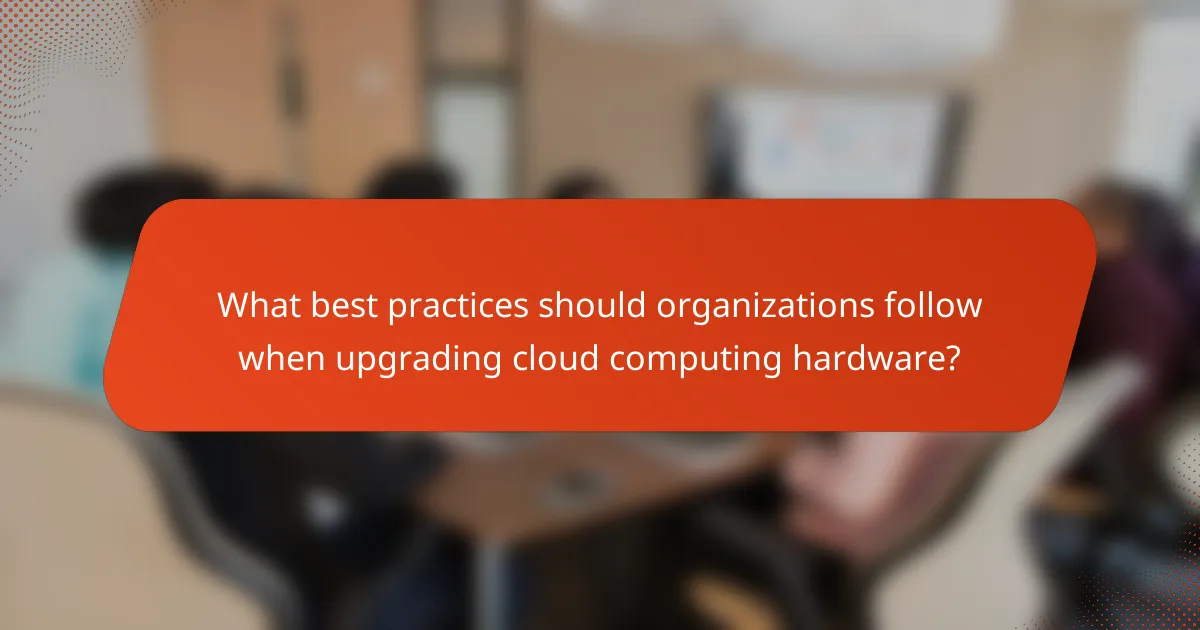
What best practices should organizations follow when upgrading cloud computing hardware?
Organizations should follow several best practices when upgrading cloud computing hardware. First, they must assess current infrastructure needs. This evaluation helps identify performance gaps and future requirements. Next, organizations should research and select hardware that aligns with their scalability goals. Choosing hardware that supports growth is crucial for long-term success.
Budget considerations are also essential. Organizations should plan for both initial costs and ongoing maintenance expenses. Additionally, it is vital to ensure compatibility with existing systems. This reduces integration issues and downtime during the upgrade process.
Testing new hardware before full deployment is another best practice. Pilot programs can identify potential issues and allow for adjustments. Finally, organizations should prioritize security features in new hardware. Enhanced security can protect sensitive data and comply with regulations.
Following these practices can lead to a smoother upgrade process and improved cloud performance.
How can organizations effectively plan for hardware upgrades?
Organizations can effectively plan for hardware upgrades by conducting a thorough assessment of current infrastructure needs. This involves evaluating existing hardware performance and identifying bottlenecks. Organizations should also forecast future requirements based on growth projections. Engaging stakeholders in the planning process ensures alignment with business goals. Budgeting for upgrades is essential to avoid financial strain. Researching the latest hardware technologies can lead to informed decisions. Establishing a timeline for implementation helps in managing resources efficiently. Regularly reviewing and updating the upgrade plan keeps it relevant to changing needs.
What steps should be taken to assess current hardware needs?
Identify the existing hardware inventory. This includes listing all current devices and their specifications. Evaluate the performance of existing hardware against current workloads. This helps in determining if the hardware meets operational demands. Analyze future growth projections for the organization. This is essential for anticipating hardware needs as the business scales. Consult with stakeholders to gather input on hardware performance and requirements. Their insights can highlight specific needs that may not be evident. Research industry standards and benchmarks for hardware performance. This provides a context for assessing if current hardware is adequate. Finally, consider budget constraints for upgrading or purchasing new hardware. This ensures that any proposed changes are financially feasible.
How can organizations ensure a smooth transition to new cloud hardware?
Organizations can ensure a smooth transition to new cloud hardware by implementing a structured migration plan. This plan should include a thorough assessment of current infrastructure and workloads. Identifying dependencies and potential impacts on business operations is crucial. Organizations should establish a timeline for migration to minimize disruption. Engaging stakeholders throughout the process enhances communication and support. Additionally, training staff on the new hardware is essential for effective use. Testing the new environment before full deployment can help identify issues. Monitoring performance post-migration ensures any problems are addressed quickly. According to a 2022 report by Gartner, organizations that follow structured migration strategies experience 30% fewer disruptions during transitions.
What common pitfalls should be avoided during hardware transitions?
Common pitfalls to avoid during hardware transitions include inadequate planning and insufficient testing. Inadequate planning can lead to unexpected downtimes and operational disruptions. Insufficient testing may result in compatibility issues and performance bottlenecks. Another pitfall is neglecting user training, which can hinder adoption of new hardware. Failing to assess current infrastructure can cause integration challenges. Additionally, overlooking data migration strategies can lead to data loss or corruption. Lastly, ignoring vendor support options may leave organizations without necessary assistance during the transition. Addressing these pitfalls ensures a smoother hardware transition process.
How can organizations mitigate risks associated with new hardware adoption?
Organizations can mitigate risks associated with new hardware adoption by conducting thorough research and planning. They should evaluate hardware specifications and compatibility with existing systems. A risk assessment should be performed to identify potential issues. Organizations can also implement pilot programs to test new hardware in controlled environments. Training staff on new technologies is crucial for smooth integration. Establishing vendor support agreements can provide assistance during the transition. Regular updates and maintenance schedules help ensure hardware reliability. According to a study by Gartner, effective planning can reduce adoption risks by up to 30%.
What strategies can be employed to ensure data security during upgrades?
Implementing data encryption is a crucial strategy to ensure data security during upgrades. Encryption protects sensitive data by converting it into a coded format, making it unreadable to unauthorized users. Regularly updating security protocols is another essential strategy. This includes applying patches and updates to software that address vulnerabilities. Conducting thorough risk assessments before upgrades helps identify potential security gaps. Utilizing access controls limits who can access data during the upgrade process. Monitoring systems for unusual activity during upgrades can quickly detect potential breaches. Employing backup solutions ensures data can be restored in case of a failure. Finally, training staff on security best practices reduces human error during upgrades. These strategies collectively enhance data security during system upgrades.
Advancements in cloud computing hardware focus on enhancing scalability, security features, and cost savings. Key developments include improved processing power from modern processors, integration of AI accelerators, and faster storage technologies like NVMe SSDs. These innovations facilitate dynamic resource allocation, bolster data protection through advanced security measures, and lead to significant operational cost reductions. The article also addresses the unique needs of various industries and outlines best practices for organizations transitioning to new cloud hardware, ensuring efficient implementation and data security.
